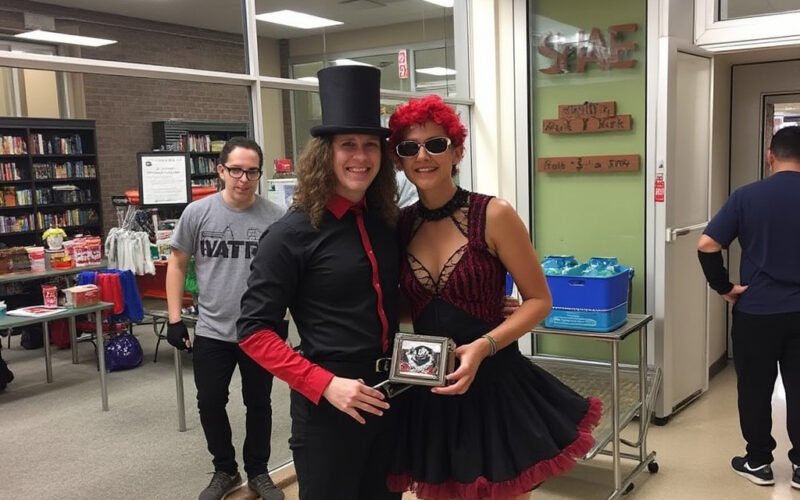Horror fandom has undergone a dramatic transformation in recent years, evolving from a niche subculture into a thriving marketplace for premium collectibles and merchandise. What was once limited to mass-produced Halloween costumes and basic movie posters has exploded into a sophisticated market of limited-edition figurines, artisanal clothing, and high-end collectibles. The surge in popularity of horror-themed apparel has been particularly notable, with online retailers like Terror Threads, Fright Rags, and Cavity Colors offering meticulously designed t-shirts and clothing that elevate horror imagery to wearable art. These boutique clothing companies have helped bridge the gap between casual fans and serious collectors, creating pieces that serve both as everyday wear and collectible items.
The Evolution of Horror Merchandise
The transformation of horror collectibles can be traced back to the early 2000s, when companies began recognizing the untapped potential of the adult collector market. While major toy manufacturers had long produced horror-themed products, these items were typically aimed at children and casual fans. The rise of companies like NECA (National Entertainment Collectibles Association) marked a significant shift in the industry, introducing highly detailed action figures and replicas that appealed to serious collectors willing to pay premium prices for quality.
The Artistic Renaissance
Perhaps the most significant development in horror collectibles has been the merger of horror imagery with high art sensibilities. Companies like Mondo have revolutionized the poster market by commissioning renowned artists to create limited edition prints of classic horror films. These pieces, often selling out within minutes of release, have transformed movie posters from simple promotional materials into coveted works of art. The success of these ventures has demonstrated that horror fans are willing to invest significantly in pieces that honor their favorite films while providing genuine artistic merit.
The Influence of Social Media
The rise of social media has played a crucial role in the evolution of horror collectibles. Platforms like Instagram and Twitter have created communities where collectors can showcase their collections, connect with artists, and stay informed about new releases. This direct line of communication between creators and consumers has led to more sophisticated products that better reflect what collectors actually want. Limited edition runs have become more common, creating a sense of exclusivity and urgency that drives the market.
Custom Craftsmanship and Attention to Detail
Modern horror collectibles are distinguished by their extraordinary attention to detail and quality of craftsmanship. Action figures now feature multiple points of articulation, screen-accurate costumes, and interchangeable parts that would have been unthinkable a decade ago. Companies like Sideshow Collectibles have pushed the boundaries even further, producing museum-quality statues and life-sized busts that can command prices in the thousands of dollars. This level of detail and quality has helped legitimize horror collecting as a serious hobby.
The Role of Licensing and Authenticity
As the market for horror collectibles has grown, licensing has become increasingly important. Companies now work directly with movie studios and creators to ensure their products are officially licensed, adding value and authenticity to their releases. This has led to more accurate representations of characters and properties, while also ensuring that artists and creators are properly compensated for their intellectual property.
Limited Editions and Exclusivity
The concept of limited editions has become central to the horror collectibles market. Manufacturers now regularly produce exclusive variants of their products, often limited to specific retailers or conventions. These limited runs create a sense of urgency and exclusivity that drives demand, while also ensuring that pieces maintain or increase in value over time. This strategy has helped transform horror collectibles from simple merchandise into legitimate investment pieces.
The Convention Circuit’s Impact
Horror conventions have evolved beyond simple fan gatherings into important marketplaces for collectibles. Events like Monsterpalooza and Texas Frightmare Weekend have become crucial venues for manufacturers to debut new products and for collectors to acquire exclusive items. These conventions also provide valuable networking opportunities for artists, manufacturers, and collectors, helping to further develop and refine the market.
Digital Authentication and Trading
The rise of digital authentication methods has helped create a more secure marketplace for horror collectibles. Online databases and certification services now help collectors verify the authenticity of their pieces, while also tracking market values and sales history. This has made it easier for collectors to make informed purchasing decisions and has helped stabilize the secondary market for rare items.
Customization and Personalization
The boutique horror collectibles market has also embraced customization, with many companies offering personalized or made-to-order pieces. This trend has allowed collectors to own truly unique items while also supporting independent artists and craftspeople. The rise of 3D printing and other new technologies has made custom pieces more accessible than ever, further expanding the market.
The Future of Horror Collectibles
As technology continues to advance and collector preferences evolve, the horror collectibles market shows no signs of slowing down. Virtual and augmented reality experiences are beginning to complement physical collectibles, while new manufacturing techniques are making increasingly detailed and complex pieces possible. The market continues to find new ways to appeal to both casual fans and serious collectors.
Conclusion
The transformation of horror collectibles from mass-market toys to premium collectibles represents a broader shift in how we view and value horror as a genre. What was once considered a niche interest has evolved into a sophisticated market that combines artistry, craftsmanship, and fandom. As the market continues to evolve, we can expect to see even more innovation in how horror properties are transformed into collectible pieces, further cementing the genre’s place in contemporary popular culture.





